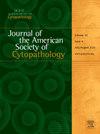三重诊断技术在超声内镜引导下细针穿刺胰腺实性病变中的应用:对诊断准确性和阳性、阴性预测值的影响
Q2 Medicine
Journal of the American Society of Cytopathology
Pub Date : 2025-03-11
DOI:10.1016/j.jasc.2025.03.001
引用次数: 0
摘要
超声引导下的内镜下细针穿刺(EUS-FNA)是一种公认的检查胰腺实性肿块病变/实性肿块的方法。报告显示,它具有很高的诊断敏感性和特异性,但不完善。灵敏度为77% ~ 98%,特异度为25% ~ 100%。据报道,阴性预测值(NPV)为72.7%,这意味着在四分之一的病例中,良性结果不能排除恶性。我们研究了细胞学、影像学和临床评估的相关性是否会提高诊断的准确性。材料和方法:对2018年至2022年在我院进行的EUS-FNA病例进行电子检索。每个病例均与相应的手术病理结果或bbb - 2年临床随访相关。随访充分的病例与影像学和临床诊断结果相关。计算了每种方法的准确性统计,以及由临床、影像学和细胞学诊断组成的三联体。结果:检索记录了198例EUS-FNAs,其中181例随访充分;临床诊断140例,影像学诊断141例。细胞学敏感性72%,特异性100%,阳性预测值(PPV) 1.00, NPV 0.79。诊断三胞胎的敏感性为93%,特异性为100%。PPV和NPV分别为1.00和0.96。结论:EUS-FNA细胞学检查的敏感性和NPV较低,表明良性诊断不能排除恶性肿瘤,近1 / 4的良性标本为假阴性。三联诊断法的灵敏度、特异性、PPV和NPV分别为93%、100%、1.00和0.96,大大提高了诊断的准确性。本文章由计算机程序翻译,如有差异,请以英文原文为准。
Application of the triple diagnosis technique to endoscopic ultrasound–guided fine-needle aspiration of solid pancreatic lesions: Impact on diagnostic accuracy and positive and negative predictive values
Introduction
Endoscopic ultrasound–guided fine-needle aspiration (EUS-FNA) is an accepted method for the investigation of pancreatic solid mass lesions/solid masses. Reports have shown it to have high but imperfect diagnostic sensitivity and specificity. Sensitivity ranges from 77% to 98% with specificity varying from 25% to 100%. Negative predictive value (NPV) has been reported to be 72.7%, meaning a benign result does not exclude malignancy in a quarter of cases. We investigated if the correlation of cytology, imaging, and clinical evaluation would improve diagnostic accuracy.
Materials and Methods
An electronic search was carried out for EUS-FNA cases performed at our institution between 2018 and 2022. Each case was correlated with corresponding surgical pathology results or >2 years clinical follow-up. Cases with adequate follow-up were correlated with results of imaging and clinical diagnosis. Accuracy statistics were calculated for each method and for a triplet composed of clinical, imaging, and cytologic diagnoses.
Results
The search documented 198 EUS-FNAs, of which 181 had adequate follow-up; 140 cases had clinical diagnoses and 141 had imaging diagnoses. The sensitivity, specificity, positive predictive value (PPV), and NPV of cytology was 72%, 100%, 1.00, and 0.79, respectively. The diagnostic triplet had a sensitivity of 93% with a specificity of 100%. The PPV and NPV were 1.00 and 0.96, respectively.
Conclusions
The sensitivity and NPV of EUS-FNA cytology were low, indicating that a benign diagnosis did not exclude malignancy with nearly a quarter of benign specimens being false negatives. The triple diagnosis method improved diagnostic accuracy substantially with sensitivity, specificity, PPV, and NPV being 93%, 100%, 1.00, and 0.96, respectively.
求助全文
通过发布文献求助,成功后即可免费获取论文全文。
去求助
来源期刊

Journal of the American Society of Cytopathology
Medicine-Pathology and Forensic Medicine
CiteScore
4.30
自引率
0.00%
发文量
226
审稿时长
40 days
 求助内容:
求助内容: 应助结果提醒方式:
应助结果提醒方式:


